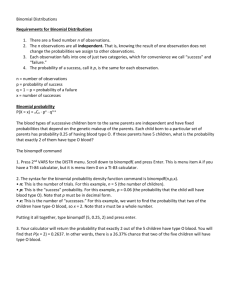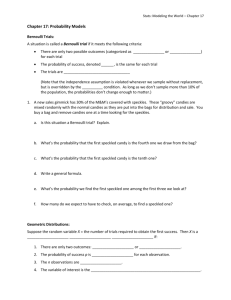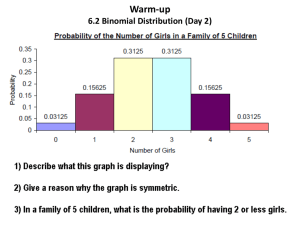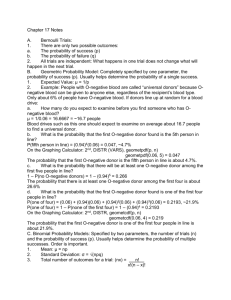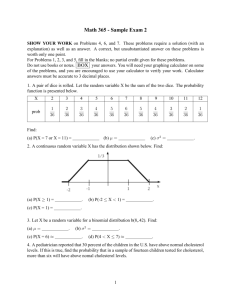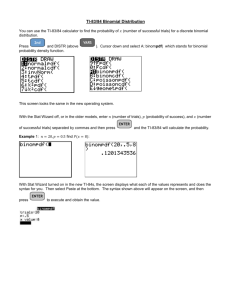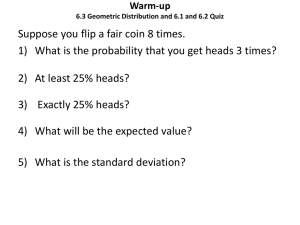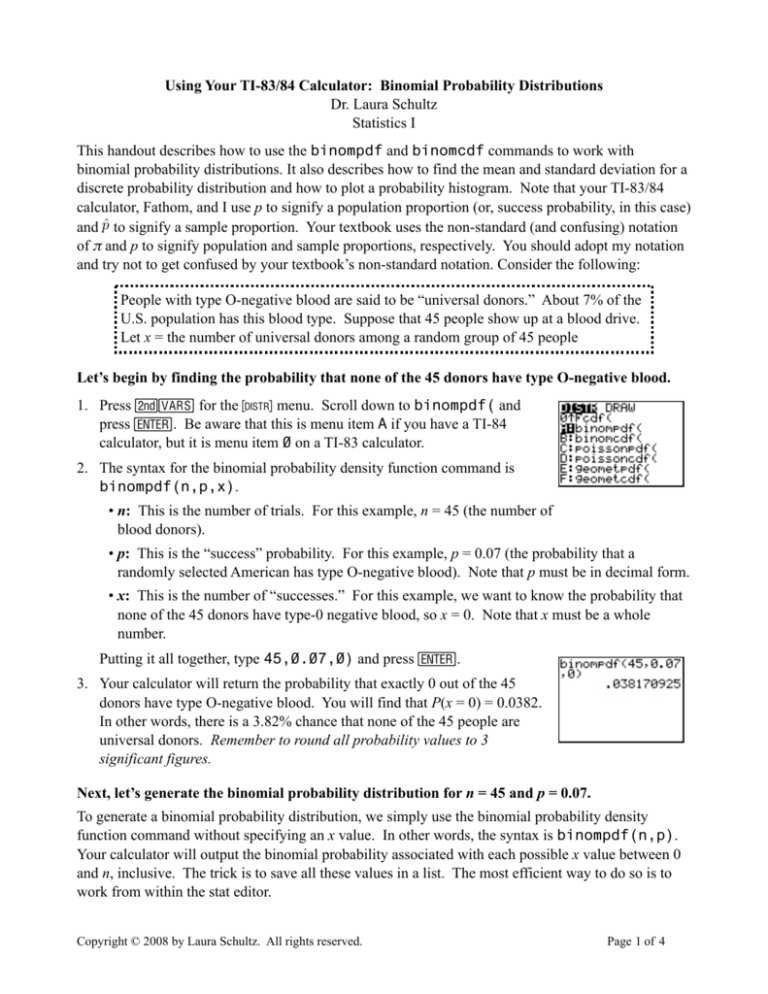
Using Your TI-83/84 Calculator: Binomial Probability Distributions
Dr. Laura Schultz
Statistics I
This handout describes how to use the binompdf and binomcdf commands to work with
binomial probability distributions. It also describes how to find the mean and standard deviation for a
discrete probability distribution and how to plot a probability histogram. Note that your TI-83/84
calculator, Fathom, and I use p to signify a population proportion (or, success probability, in this case)
and p̂ to signify a sample proportion. Your textbook uses the non-standard (and confusing) notation
of π and p to signify population and sample proportions, respectively. You should adopt my notation
and try not to get confused by your textbook’s non-standard notation. Consider the following:
People with type O-negative blood are said to be “universal donors.” About 7% of the
U.S. population has this blood type. Suppose that 45 people show up at a blood drive.
Let x = the number of universal donors among a random group of 45 people
Let’s begin by finding the probability that none of the 45 donors have type O-negative blood.
1. Press `v for the = menu. Scroll down to binompdf( and
press e. Be aware that this is menu item A if you have a TI-84
calculator, but it is menu item 0 on a TI-83 calculator.
2. The syntax for the binomial probability density function command is
binompdf(n,p,x).
• n: This is the number of trials. For this example, n = 45 (the number of
blood donors).
• p: This is the “success” probability. For this example, p = 0.07 (the probability that a
randomly selected American has type O-negative blood). Note that p must be in decimal form.
• x: This is the number of “successes.” For this example, we want to know the probability that
none of the 45 donors have type-0 negative blood, so x = 0. Note that x must be a whole
number.
Putting it all together, type 45,0.07,0) and press e.
3. Your calculator will return the probability that exactly 0 out of the 45
donors have type O-negative blood. You will find that P(x = 0) = 0.0382.
In other words, there is a 3.82% chance that none of the 45 people are
universal donors. Remember to round all probability values to 3
significant figures.
Next, let’s generate the binomial probability distribution for n = 45 and p = 0.07.
To generate a binomial probability distribution, we simply use the binomial probability density
function command without specifying an x value. In other words, the syntax is binompdf(n,p).
Your calculator will output the binomial probability associated with each possible x value between 0
and n, inclusive. The trick is to save all these values in a list. The most efficient way to do so is to
work from within the stat editor.
Copyright © 2008 by Laura Schultz. All rights reserved.
Page 1 of 4
1. Press Se to enter the stat editor. Clear out both L1 and L2 with
the C key.
2. Position the cursor on the L2 list name. Type `v to bring up the
= menu. Select binompdf( and press e.
3. You will be returned to the stat editor. Finish off the command by typing
45,0.07) and then press e.
4. Your calculator will fill up L2 with the probabilities for 0 ≤ x ≤ n
successes.
5. We kept L1 empty because it is useful to indicate the x value that
corresponds to each probability value stored in L2. You could go through
and type in each x value manually, but it is often easier to generate these
values automatically. Highlight L1 and press `S to bring up the
9 menu.
6. Use the right arrow key to scroll to the OPS menu. Select 5:seq( and
press e.
7. You will be brought back to the stat editor. Complete the command by
typing X,X,0,45) and press e. (Note: Press a= to type
an “X.”) The general syntax for this command is seq(X,X,0,n).
8. Your calculator will fill L1 with the whole numbers from 0 to 45.
9. Together, L1 and L2 comprise the binomial probability distribution for n
= 45 and p = 0.07. Use the ; and : keys to scroll through all the
entries in L1 and L2.
Working with a binomial probability distribution
1. Let’s use the distribution we just generated to find the probability that at least one of the 45
donors has type O-negative blood. The tedious approach would be to add up P(x = 1) + P(x = 2)
+ P(x = 3) +. . .+ P(x = 45). Don’t! Instead, take advantage of the fact that the complement of “at
least one” is “none.” Thus, P(1 ≤ x ≤ 45) = 1 - P(x = 0) = 1 - 0.0381709250 = 0.962. Remember
to hold off rounding to 3 significant figures until the end.
2. Next, let’s find the probability that no more than three of the donors have type O-negative
blood. To do so, we need to find P(x = 0) + P(x = 1) + P(x = 2) + P(x =
3). You could write down the corresponding probabilities from L2 and
then add them up.
3. Alternatively, we can use the sum command and specify the range of
items in L2 that we wish to add up. The key is to remember that the first
item in the list, L2(1), corresponds to P(x = 0); that is, the row number
corresponds to x + 1. Press `S for the 9 menu and scroll right
for the MATH menu. Scroll down to 5:sum( and press e.
4. The syntax for the sum command is sum(list,start,end). For
this example, type `2,1,4) and press e. This command
Copyright © 2008 by Laura Schultz. All rights reserved.
Page 2 of 4
tells your calculator to sum the contents of rows 1 through 4 in L2. We find that P(x ≤ 3) = 0.613.
In other words, there is a 61.3% chance that no more than three of the 45 donors have type Onegative blood.
5. A third approach is to use the binomcdf command. This command
finds the cumulative probability of obtaining x or fewer successes. The
syntax is binomcdf(n,p,x). This command is a useful whenever
you are asked to find the probability of “no more than” x successes. To
find the probability that no more than three of the donors have type Onegative blood, use binomcdf(45,0.07,3). This command tells
your calculator to find P(x = 0) + P(x = 1) + P(x = 2) + P(x = 3), which is
exactly what we need to do here. We obtain the same answer as before,
P(x ≤ 3) = 0.613.
6. Through creative combinations of the binompdf and binomcdf
commands, you will find it possible to solve any sort of binomial
probability problem that comes your way. Suppose that we want to find
the probability that at least two of the donors have type O-negative
blood. Recognize that this is the complement of no more than one of the
donors having this blood type, and you can easily solve this problem.
Note from the screenshot that you can add or subtract probabilities
directly from the command line. We find that P(x ≥ 2) = 1 - P(x ≤ 1) = 0.833.
7. As a final example, let’s find the probability that between 4 and 8 of the
donors have type O-negative blood. That is, find P(4 ≤ x ≤ 8). You
could solve this problem using the sum( command and your binomial
probability distribution. Alternatively, you can strategically use the
binomcdf command. Note that P(4 ≤ x ≤ 8) = P(x ≤ 8) - P(x ≤ 3). By
subtracting out P(x ≤ 3), we are making sure that P(x = 4) is included in
our calculations. Using the binomcdf command as shown to the right,
we find that P(4 ≤ x ≤ 8) = 0.384. Using this approach saves you from
having to generate the binomial probability distribution and figure out
the correct rows to add up.
Summary: binompdf vs. binomcdf commands
Here are some useful applications of the binomcdf and binomcdf commands:
• To find P(x = k), use binompdf(n,p,k)
• To find P(x ≤ k), use binomcdf(n,p,k)
• To find P(x < k), use binomcdf(n,p,k-1)
• To find P(x > k), use 1-binomcdf(n,p,k)
• To find P(x ≥ k), use 1-binomcdf(n,p,k-1)
Note: k refers to some number of successes between 0 and n.
Copyright © 2008 by Laura Schultz. All rights reserved.
Page 3 of 4
How to find μx and σx for a discrete probability distribution
1. What is the expected number of universal donors out of the 45 people who show up at the blood
drive? For all discrete random variables, E(x) = µx = x · P (x) . For a binomial probability
distribution, E(x) = μx = np. For this example, E = (45)(0.07) = 3.15 (round to 3.2). We can find
both μ and σ for a binomial probability distribution (or any other type of discrete probability
distribution) by using the 1-Var Stats command.
2. Press S and scroll right to the CALC menu. Press e to select
1:1-Var Stats. Type `1,`2 and press e. (You must
enter the list containing the x values first, then the list containing the P(x)
values.)
3. Your calculator will return the output screen to the right. Note that what
it calls x̄ is really μ. Rounding to one more decimal place that we started
with, we find that the expected number of universal donors out of 45 is
3.2 people, with a standard deviation of 1.7 people.
How to construct a probability histogram
1. Let’s plot a probability histogram. Press `! for the , menu. Make sure only Plot1 is
turned on. Select the histogram plot Type. The Xlist is L1 (the list containing the x values), and
Freq is L2 (the list containing the P(x) values).
2. If you press #9, you will get an inappropriate plot. (Go ahead and
see what I mean.) We need to set the window variables. Press @.
Here are some guidelines on how to choose the proper settings:
• Xmin: Should always be 0 (the lowest possible value of x)
• Xmax: Start by using one more than the highest possible value of x in
your probability distribution (46, for this example)
• Xscl: Should always be 1
• Ymin: Should always be 0
• Ymax: Pick a value slightly higher than the largest P(x) value in L2 (Use 0.25 for this example)
• Yscl: Sets the spacing for the y-axis tick marks (0.1 is fine for this example)
• Xres: Leave it set to 1
3. Press % to generate the probability histogram. (Don’t use #!) Then, press $ and
use the > and < keys to confirm that the histogram corresponds to the binomial probability
distribution saved in L1 and L2.
4. Change the Xmax window setting to make your histogram easier to read.
I used Xmax=14 here. You’ll occasionally need to experiment with the
window settings to get a plot that captures the shape of the probability
distribution, yet is still readable.
Copyright © 2008 by Laura Schultz. All rights reserved.
Page 4 of 4

